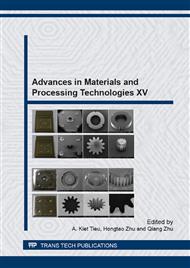[1]
J.S. Kang, Study on the remediation of oil-contaminated soil using thermal desorption, Pusan National University, Master's Thesis, 2003, p.50.
Google Scholar
[2]
G.H. Kim, The Relation Between Treatment Effi-ciency and Operation Condition of Oil Contaminated Soil by Low-Temperature Thermal Desorption (LTTD), Yeosu University, Master's Thesis, 2005, pp.4-7.
Google Scholar
[3]
Standard Method for Examination of Soil. (2007)
Google Scholar
[4]
A.C. Metaxas and R.J. Meredith, Industrial Microwave Heating, Power Engineering Series 4, Peter Peregrinus Ltd.(on behalf of the IEE). (1993)
Google Scholar
[5]
A.P. Schwab, J. Wetzel, S. Pekareck, and M.K. Baks, Extrachtion of petroleum hudrocarbons from soil by mechanical shaking, Environ. Sci, Technol. 33(11) (1999) 1940-1945.
DOI: 10.1021/es9809758
Google Scholar
[6]
Korea Institute of Science and Technology, Development of Remediation Technology of oil Contaminated Site, Ministry of Science and Technology Report, 1999, pp.426-473.
Google Scholar
[7]
B.G. Jung, D. Y. Kim, and J. K. Kim, Enhanced TPH Degradation of Diesel-Contaminated Soil by Microwave Heating, J. of the Korean Environ. Sci. Soc. 17(5) (2008) 479-484.
DOI: 10.5322/jes.2008.17.5.479
Google Scholar
[8]
T.S. Marline, B. Franco, and K.M. Anil, Thermal desorption treatment of contaminated soils in a novel batch thermal reactor, Indus. Eng. Chem. Research 40, (2001) 5421-5430.
DOI: 10.1021/ie0100333
Google Scholar
[9]
D.L Urban and M.J Antal, Study of the kinetics of sewage sludge pyrolysis using DSC and TGA, Fuel 61 (1982) 799-806.
DOI: 10.1016/0016-2361(82)90306-4
Google Scholar
[10]
S. Kim and H.D. Chun, Analytical techniques estimating kinetic parameters for pyrolysis reaction of scrap tire, Korea J. of Chem. Eng. 12 (1995) 448-459.
DOI: 10.1007/bf02705809
Google Scholar
[11]
N.A. Liu and W.C. Fan, Critical consideration on the Freeman and Carroll method for evaluation global mass loss kinetics of polymer thermal degradation, Thermochimica Acta 338 (1999) 85-94.
DOI: 10.1016/s0040-6031(99)00197-5
Google Scholar
[12]
T.S. Laverghetta, Practical Microwaves, prentice-Hall, New Jersey, 1996.
Google Scholar
[13]
J. Jacob, L.H.L. Chia, and F.Y.C. Boey, Review thermal and non-thermal interaction of microwave radiation with materials, J. of Mater. Sci. 20 (1995) 5321-5327.
DOI: 10.1007/bf00351541
Google Scholar


